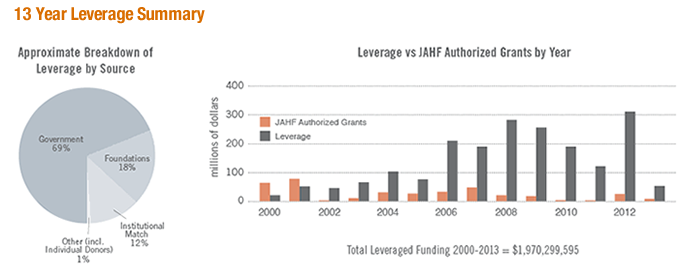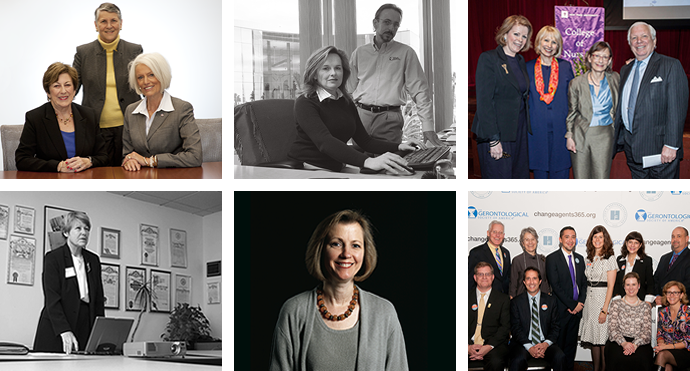The Five Principles
of Successful Partnerships
There is power in partnerships.
It manifests in myriad ways. In a funding environment in which resources to address aging and health are relatively scarce, partnerships are critical to make the changes needed to meet the growing health care needs of older adults.
The John A. Hartford Foundation has a long track record of collaborating with other foundations, levels of government, organizations, and individuals who share our vision and goals. These partnerships are a two-way street that benefit and extend the reach of all concerned. By pooling resources, talents, and expertise, we create a path for our mission that is more lasting and sustainable.
Fact: During the next 20 years, nearly 10,000 people will turn 65 each day, doubling the number of older adults in the United States.
“Partnering defines our work and is a major strategy of the Foundation,” says Corinne H. Rieder, EdD, the Foundation’s executive director and treasurer. “We can do more to improve the health of older adults by actively seeking out and working with partners who share our mission. None of us can do it alone.”
First, there is the financial impact. Since 2000, the Hartford Foundation has authorized grants totaling $398.3 million to improve the health of older adults. Through strategic funding partnerships with government agencies, foundations, other institutions and through subsequent development efforts of our grantees and scholars, those grants generated a total of $1.97 billion in related funding in health and aging.
That adds up to more than $4.95 leveraged for every dollar of Hartford funding.

Almost three out of every four projects financially supported by the Foundation have external co-funders, and Hartford currently has 104 partners, ranging from the National Institute on Aging (NIA), the Administration for Community Living, and the Department of Veterans Affairs (VA) in the government sector, to the California HealthCare Foundation, the F.B. Heron Foundation, and the Margaret A. Cargill Foundation in the nonprofit philanthropic world.
And in what may come as a surprise to many, 69 percent of the Foundation’s leveraged funding is from government agencies. That reflects an important historical trend, as the federal government has invested increasingly in aging and health over the past two decades.
In many ways, it also reflects history repeating itself, in the sense that it marks the second time—first in medical research, then aging and health—that the federal government has invested in an area after the Hartford Foundation stepped in to meet a pressing national need.
The John A. Hartford Foundation was founded by A&P grocery chain President John A. Hartford in 1929, the same year that A&P became the first retailer to reach $1 billion in annual sales. In the 1950s, following the deaths of Hartford and his brother, A&P Chairman George L. Hartford, A&P stock contributions from their estates made the Hartford Foundation the fourth largest philanthropy in the country.
The Foundation at the time did what philanthropies do: It saw a need that was not being met by the government or private sector and filled it. Over the next two decades, the Hartford Foundation became the largest private, not-for-profit supporter of medical research in the United States, spending $10 for every $1 in government support. The resulting advances included pioneering technologies and treatment innovations for organ transplantation, kidney dialysis, heart disease, non-invasive cataract surgery, and cancer, among others.
But the funding landscape changed dramatically in the 1970s. A&P stock declined in value, leaving the Foundation with less money to invest at a time when the cost of medical research was greatly increasing. Meanwhile, the National Institutes of Health (NIH) had grown from two institutes in 1950 to 15 by 1970, and in the early 1970s, Congress funded major initiatives to fight cancer and heart disease. NIH support for medical research grew to a level far beyond the means of even the largest foundation or private funding source.
As the Hartford Foundation began to wind down its biomedical research projects in the late 1970s, the Trustees once again looked for an area in which the Foundation, in the words of John A. Hartford, could “do the greatest good for the greatest number.” In 1982, the Foundation launched its Aging and Health program, once more stepping up to address a need that was not being adequately met by government or private funding.
Over the next three decades, the Foundation pursued an “upstream strategy”—focusing its grantmaking on championing geriatrics research, education, and the development and dissemination of evidence-based, cost-effective models of care. In this work, the Foundation has actively sought to partner with other foundations and organizations and, increasingly, with the federal government to leverage its relatively modest resources so that they would have maximum impact on behalf of older Americans. And just as it had done with medical research decades earlier, the NIH has taken on much of the support for aging and health and has become an important partner in sustaining and expanding valuable programs started by the Hartford Foundation.
Twice since 2000, the nation has experienced severe economic downturns—first when the tech bubble burst shortly after the turn of the 21st century, and then with the 2008 Great Recession. Following the first financial crisis, the Hartford Foundation concluded that it could no longer continue funding the Paul B. Beeson Career Development Awards in Aging Research, which at the time was the biggest private award for aging-focused researchers in academic medicine. For two years, Hartford staff, led by Dr. Rieder, worked to find other foundation partners to keep the Beeson Scholars Program alive. When those efforts failed to bear fruit, Dr. Rieder—who formerly worked in the federal government—came up with an outside-the-box solution, reaching out to the NIA about stepping in to fund the Beeson program. The notion of having a federal agency, with all of its rules and regulations, take over administration of a private career development award seemed like a long shot at best. But the NIA, Hartford, and the program’s other partners were committed to making what at the time was a groundbreaking partnership work, and today, the Beeson Scholars program is stronger than ever. (For the complete story, see The Best of Both Worlds: Forging a Model Public-Private
Partnership.)
“Over the past century, almost all the compelling examples of philanthropic impact involve multiple grantmakers, nonprofits, and other organizations working together toward common goals.”
Phil Buchanan
President
Center for Effective Philanthropy
writing in The Chronicle of
Philanthropy

(Top row)
(Left) Corinne H. Rieder, EdD (center), Executive Director and Treasurer of the Hartford Foundation; with grantee Nelma Shearer, PhD, RN (right), Director, Hartford Center of Gerontological Nursing Excellence, Arizona State University; and funding partner Carol A. Kratz, MPA (left), formerly of Virginia G. Piper Charitable Trust.
(Middle) Gretchen E. Alkema, Vice President, Policy and Communications; and René Seidel, Vice President, Programs and Operations, the SCAN Foundation.
(Right) Hartford Board Chair, Norman Volk (right) attending the Norman and Alicia Volk Lecture on Geriatric Nursing at New York University with his wife Alicia (left); Tara Cortes, PhD, RN, Director of the Hartford Institute for Geriatric Nursing; and presenter Diane Meier, MD, Director, Center to Advance Palliative Care.
(Bottom row)
(Left) W. June Simmons, MSW, CEO, Partners in Care Foundation, shares the success of a Hartford Social Work model.
(Middle) Mary Ellen Kullman, MPH, Vice President, Archstone Foundation, has been a long-term partner of the Hartford Foundation.
(Right) The Hartford Change AGEnts Leadership team at the launch of the new Initiative at the 2013 Annual Meeting of the Gerontological Society of America.
Keys to thriving partnerships
Successful partnerships take a lot of work. They require the ability to identify and invest in strong leaders and projects, as well as a strategic and deliberate approach to networking: getting to know key players in other foundations, government agencies, and organizations and remaining in frequent contact with them.
The Hartford Foundation actively searches for new potential partners and has consulted in the development of new foundations. On a national level, Hartford has been an active leader in foundation affinity groups in aging and health. The Foundation also regularly invites other funders to participate in annual Hartford evaluation site visits.
“The right partnerships amplify the impact not only of the Hartford Foundation, but of those with whom we collaborate,” says Christopher A. Langston, PhD, program director. “As we continue to shift to our ‘downstream’ strategy to create real and meaningful practice change in the health care of older adults, partnerships will continue to play an essential role.”
Beyond Dollars: The Benefits of Partnership
The benefits of collaboration go far beyond simply increasing the amount of money available for worthy projects and programs.
Working together, like-minded partners can not only leverage their funding, they can pool their knowledge, creativity, and efficiency—broadening the scope of their thinking, while increasing their ability to maximize their impact. In the end, it comes down to ensuring that the collaboration is a win-win for both partners.
Consider the example of Carol A. Kratz, MPA, who joined Virginia G. Piper Charitable Trust, located in Phoenix, Arizona, with a specific regional focus in Maricopa County. Ms. Kratz was a program officer at Piper Trust’s inception, when it decided to make the health of older adults one of its priority funding areas.
“When we first opened our doors and started competitive grantmaking in 2001, I was anxious to find out what was happening in the field,” Ms. Kratz recalls. “My research at that time focused on the leading funders of initiatives for older adults—what types of programs were they investing in and would they make sense to replicate in our community?”
Ms. Kratz began attending Grantmakers In Aging (GIA) conferences and got to know several Hartford program staff, drawing on their knowledge and experience in the field. During the next six years, those relationships deepened, and in 2007, when the Hartford Foundation approved a $1 million grant to establish a Hartford Center of Gerontological Nursing Excellence at Arizona State University, Piper Charitable Trust invested $500,000 as a local match (‘The Perfect Storm’).
For many years, the Foundation has taken a strategic approach to partnerships, finding ways to share expertise and relationships, as well as dollars.
As Mary Ellen Kullman, MPH, vice president of the Archstone Foundation in Long Beach, CA—which has partnered with Hartford on numerous projects through the years—puts it: “There’s far more room to work in this field than there are resources available. So the more we can bring new people into the field and nurture their growth, the more it facilitates our ability to do our work and ultimately serve the elders we want to serve.”